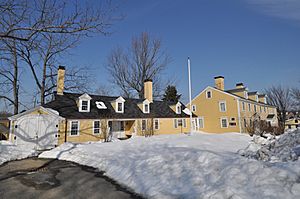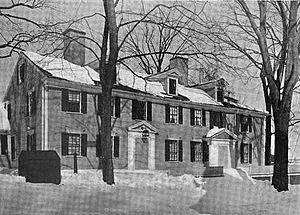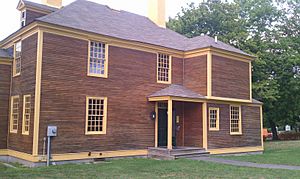American Independence Museum facts for kids

Ladd-Gilman House, main building of the American Independence Museum
|
|
| Established | 1991 |
|---|---|
| Location | One Governor's Lane Exeter, New Hampshire |
| Type | History museum |
| Public transit access | Exeter Station 0.6 miles (0.97 km) |
| Nearest car park | Spring and Water streets (no charge) |
The American Independence Museum is a cool place in Exeter, New Hampshire where you can learn about American history. It's a historic house museum, meaning it's set up in old, important buildings.
The museum has two main buildings. One is the Ladd-Gilman House, built in 1721. It's so important it's a National Historic Landmark. The other is the Folsom Tavern, built in 1775.
The museum opened in 1991. This happened after a very rare copy of the Declaration of Independence was found in the Ladd-Gilman House. This special copy is called a Dunlap Broadside. It's the most important item the museum has! The museum's goal is to connect America's past with today.
Contents
History of the Museum
The American Independence Museum first opened its doors in 1991. This was six years after a rare Dunlap Broadside was discovered in the attic of the Ladd-Gilman House. The group that owned the house, the Society of the Cincinnati, decided to open the museum. They wanted to teach people about the Declaration of Independence and the American Revolution.
Since then, the museum has also fixed up the Folsom Tavern. This added more space and things to see. Today, the museum focuses on the Revolutionary War. It also highlights the important role of Exeter and the Gilman family in creating the new United States.
The Ladd-Gilman House: A Family's Role in History
The Ladd-Gilman House was home to an important family in the 1700s. Members of this family helped create the United States. Nicholas Gilman, Sr. was the treasurer for New Hampshire during the American Revolution. At that time, Exeter became the capital of New Hampshire.
His oldest son, John Taylor Gilman, read the Declaration of Independence to the people of Exeter in 1776. He later became the New Hampshire governor many times. Another son, Nicholas Gilman, Jr., was a soldier in the Continental Army. He also signed the U.S. Constitution.
In the early 1900s, the Society of the Cincinnati bought the house. They used it as a meeting place. Later, they turned it into the museum we see today. You can tour seven rooms in the house. Other parts are used for museum offices and a research library.
The Folsom Tavern: A Revolutionary Meeting Place
| Folsom Tavern | |
|---|---|

Restored front of the Folsom Tavern, facing Water Street in downtown Exeter
|
|
| Location | 164 Water Street Exeter, New Hampshire |
| Built | 1775 |
| Built for | Colonel Samuel Folsom |
|
N.H. State Register of Historic Places
|
|
| Designated | October 29, 2018 |
Exeter was the capital of New Hampshire when Colonel Samuel Folsom built his tavern in 1775. During the American Revolutionary War, many important political talks happened here. It was a popular spot for men in town.
The New Hampshire chapter of the Society of the Cincinnati was formed in this tavern in 1783. Even George Washington visited the tavern on November 4, 1789, during his tour of the states. After Colonel Folsom passed away in 1790, his wife and daughters kept the tavern running. It became known as "Widow Folsom's Tavern." The Folsom family owned it until 1856.
The Society of the Cincinnati bought the tavern in 1929. They moved it next to the Ladd-Gilman House. In 1947, a woman named Martha Foster Stearns helped restore the tavern. She lived there until 1956. From 1956 to 1992, the tavern was rented out to Phillips Exeter Academy for teachers to live in.
In 2004, the tavern was moved to its current spot on the museum grounds. It was carefully restored with a new roof and siding. Inside, work began in 2006. The tavern officially opened in 2007. Now, it's part of the museum's regular tours. It's also used for museum events and can be rented for other gatherings. Folsom Tavern was added to the New Hampshire State Register of Historic Places in 2018.
Museum Collections: Treasures of History
The museum has many amazing historical items. These include the Dunlap Broadside, which is a copy of the Declaration of Independence. They also have two early copies of the U.S. Constitution. Another special item is a Badge of Military Merit. This was the original Purple Heart, given by General George Washington for bravery.
Other items in the museum include old furniture and art from the 1700s and 1800s. You can also see weapons from the 18th century. There are also old letters, documents, and portraits of important American leaders.
The Dunlap Broadside: A Rare Discovery
In 1985, this special copy of the Declaration of Independence was found. It was hidden in the floorboards upstairs in the Ladd-Gilman House. Electricians were installing a security system when they found it! This was the 23rd copy of the Dunlap Broadside ever found. Now, there are 26 copies known to exist.
These copies of the Declaration were printed by John Dunlap on the night of July 4, 1776. He was asked to print between 150 and 200 copies. One copy went to each state capital and military camp. Some were even sent to England to tell King George III the news. The museum's copy arrived in Exeter on July 16, 1776. John Taylor Gilman read it aloud to the people of Exeter.
The Dunlap Broadside is only shown once a year. You can see it on the third Saturday of July. This is during the museum's American Independence Festival. The festival celebrates when the document arrived and was read in Exeter.
Museum Programs and Events
The museum is open from May through November. You can visit Thursday through Saturday, from 10 AM to 4 PM. Guided tours of the Ladd-Gilman House and Folsom Tavern are offered at 10 AM, noon, and 2 PM. You can also take a self-guided tour until 3 PM. The museum hosts many public events. The biggest one is the American Independence Festival, held every July. This festival brings thousands of visitors to learn about America's 18th-century history.
American Independence Festival: A Celebration of Freedom
The American Independence Festival is a big event put on by the American Independence Museum. It used to be called the Revolutionary War Festival. It happens every year on the third Saturday in July. This festival remembers when the Dunlap Broadside was first read in Exeter on July 16, 1776.
The celebration starts with a parade of reenactors. Then, the Declaration of Independence is read aloud to everyone at the festival. The original Dunlap Broadside is displayed inside the museum during the festival. You can also see artisans showing traditional crafts. There are also craft booths, local non-profit groups, and food vendors. Thousands of people come to this event every year!



